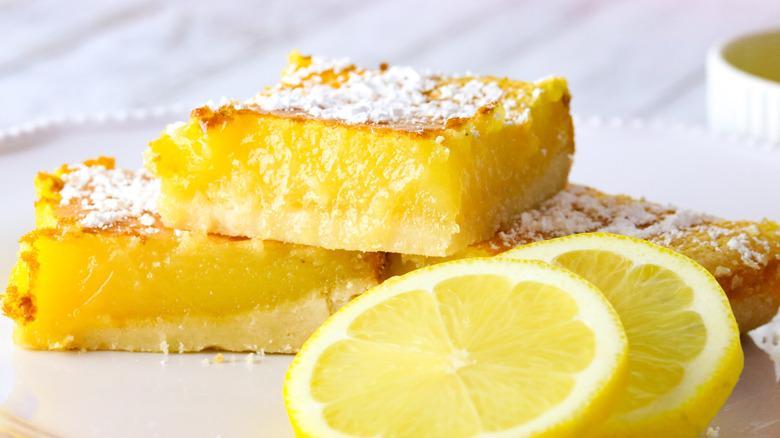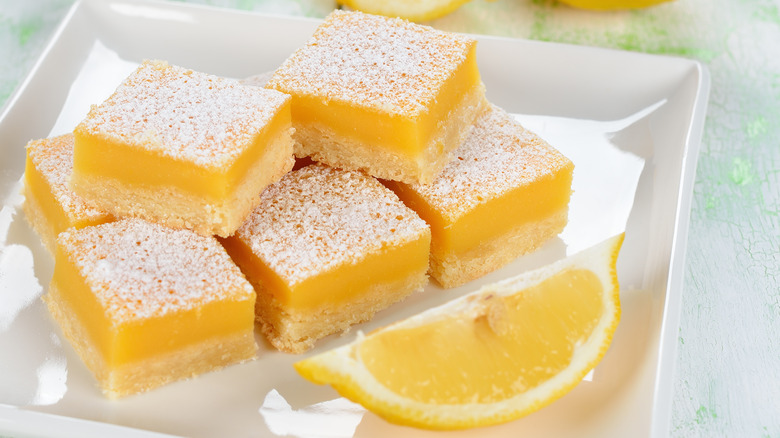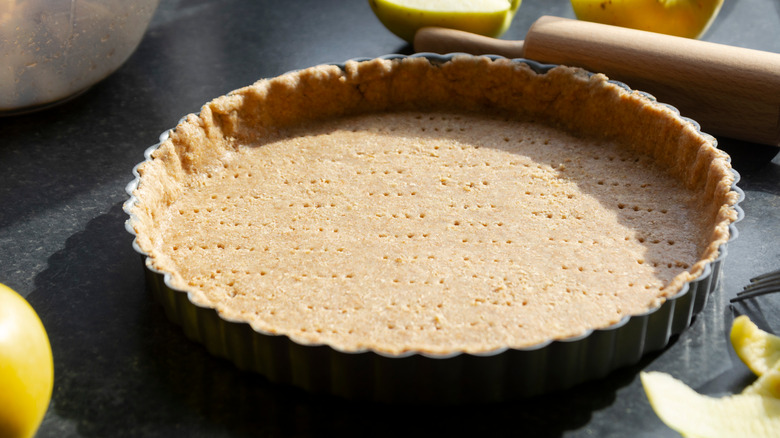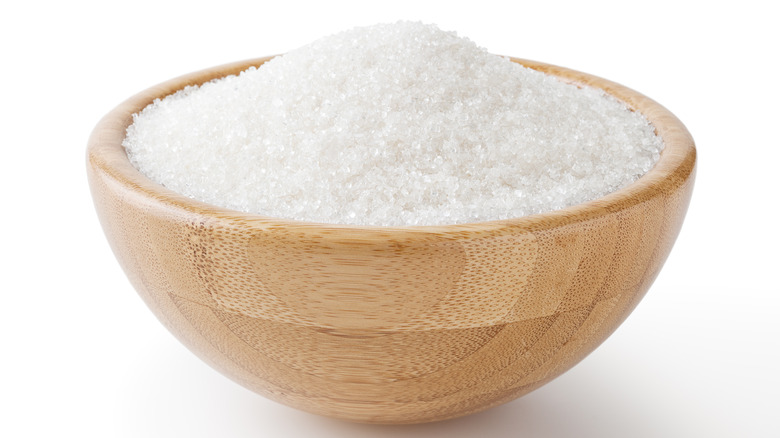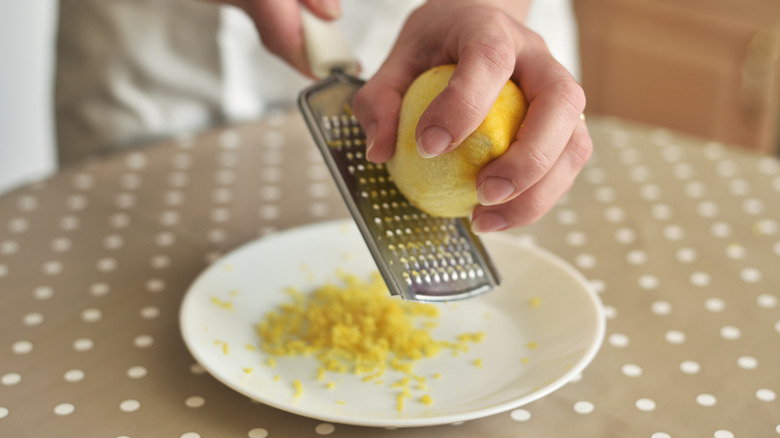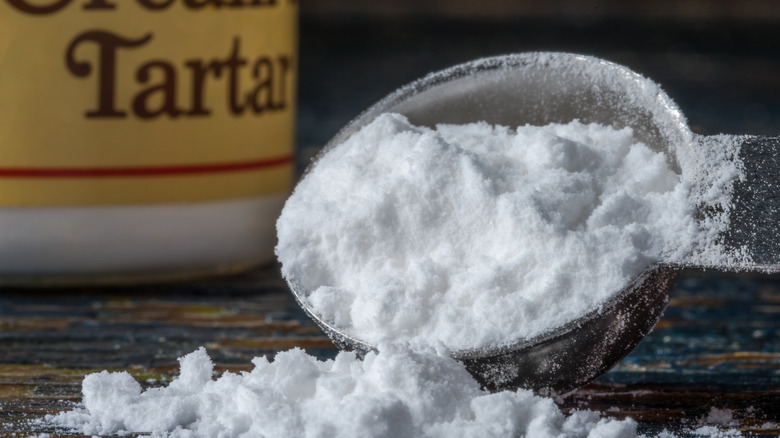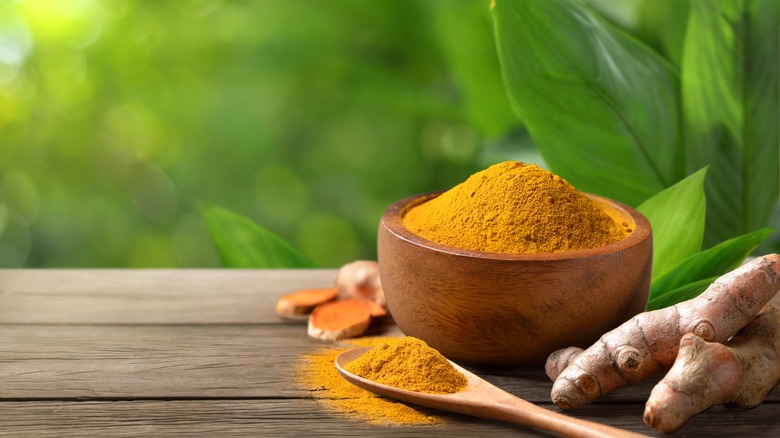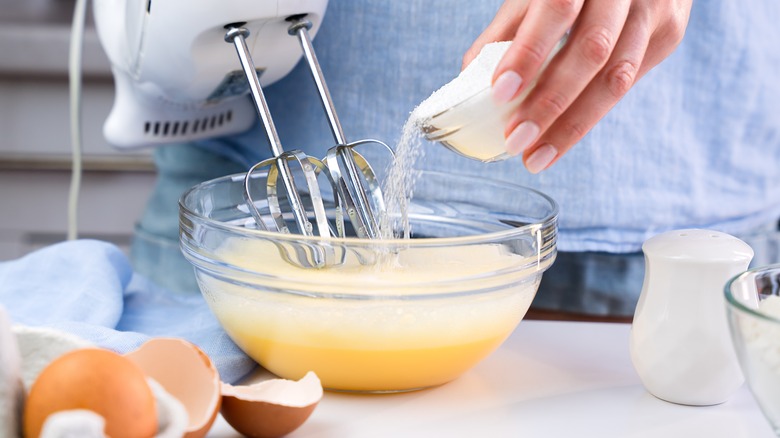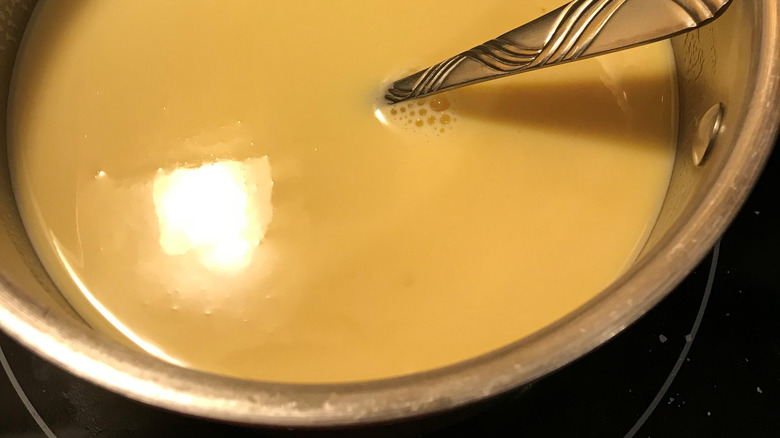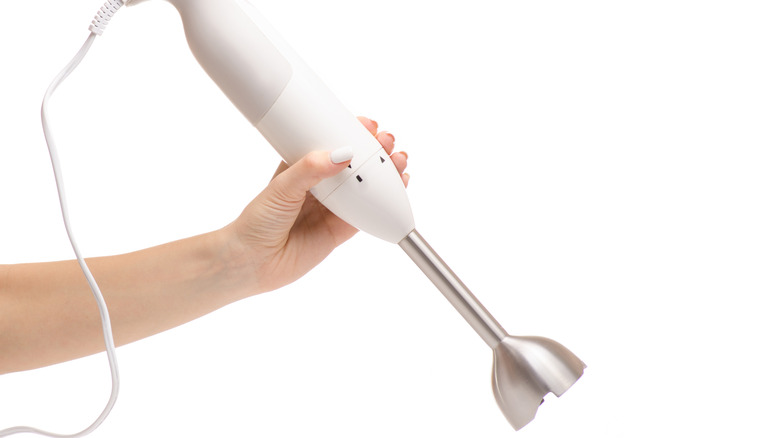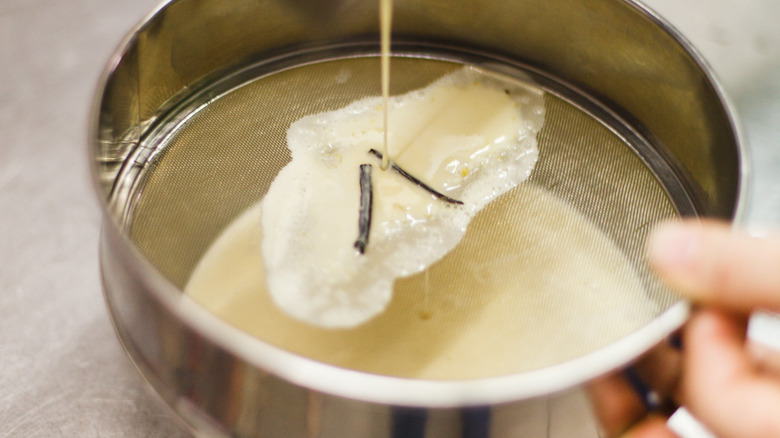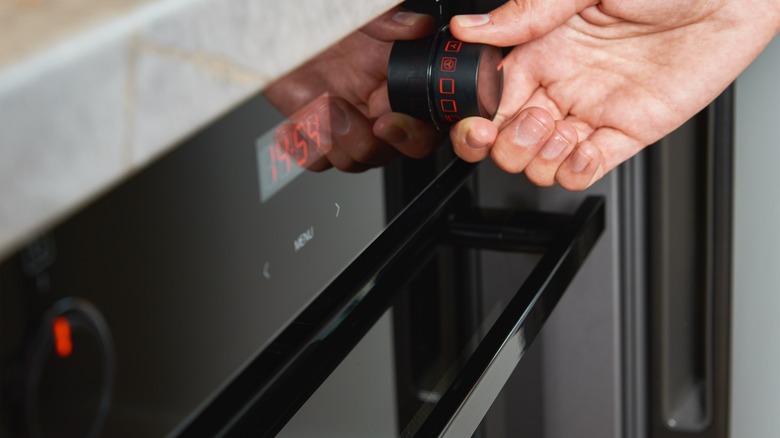12 Ways To Take Your Lemon Squares Up A Notch
Who doesn't love the intense citrusy goodness of a lemon bar? Sinking your teeth into a glossy layer of lemony-custard-meets-buttery-shortbread can be quite heavenly. But not every lemon bar meets an exceptional quality of flavor balance, texture, and a well-rounded appeal. Perhaps the custard is too runny, your crust is too dense, or the intensity of your custard or lemon curd just doesn't meet expectations — too tart, too sweet, not enough of a lemony punch. Then there's curdling (which can happen if you don't mind your custard), a shortbread that is soggy, or a crust that is neither tender nor crisp (more like a layer of cardboard, instead).
Maybe you've created a decent lemon bar that fits flavor and textural expectations, but is somehow missing that extra pizazz? Your tongue is telling you that there's something missing, and yet, you don't know quite what that is. Learn just what you can do to take your lemon bar to the next level to wow your taste buds and impress your guests right here.
1. Get the ideal custard to crust ratio
Two good things don't always make a perfect match. You may have a great lemon custard or a lemon curd, and your shortbread crust may be heavenly. But too much of one can overpower the other. A rich, buttery crust is appealing, but, in this situation, it isn't supposed to steal the show. To get your lemon square just right, you have to watch your proportions. After all, it's called a lemon bar for good reason — if you were after a shortbread with a lemony glaze, you'd be seeking a different recipe.
However, that doesn't mean you'll want it custard-heavy. That could make it excessively sweet and overly tart. So, finding the right balance of custard to crust is ideal. According to Cook's Illustrated, that means you'll want your filling to be twice the thickness of your crust. No more, no less. It's the perfect way to get the best of both components for a well-rounded, mouth-watering experience. A 2:1 ratio of lemon filling to crust will allow the right balance of flavors — a buttery crust can complement the intense and bright lemony layer only if it's just enough to tone down tartness.
2. Be mindful preparing your crust
If you follow a good recipe, you'll be aware that a shortbread crust is more than just the combination of its ingredients. The butter should be room temperature, so you'll have a pliable mass of dough you can easily work with your hands. The cold-butter "rule" that works for classic fruit pies and quiche-worthy crusts goes out the door when you are making a shortbread. And, you'll want to press the dough firm and level in the pan so that the crust cooks evenly. What's more, par-baking is essential because the cooking time is different for the custard and the crust. This will prevent your crust from getting soggy (it has a wet filling, after all).
Try Mashed's Easy Lemon Bar Recipe for a good quality crust. You'll note that holes are poked into the crust after par-baking to ensure the lemony custard and the tart's base don't go separate ways when you are ready to eat it. Those tiny pricks (again, after par-baking) ensure an adhesive quality.
3. Swap out confectioners for granulated sugar (in your dough)
A buttery crust will complement your custard's sweet-acidic tones, but if you want to take your shortbread to the next level, swap out the confectioner's (powdered) sugar for granulated sugar when preparing your dough. You'll still get the flavor quality and a pleasant result, but you'll also get a bit of crispness, making for an even greater partner to your smooth, lemony custard than a traditional melt-in-your-mouth shortbread crust.
Besides sweetness, sugar adds texture and structure to your baked dishes. Since sugar draws the water away from other starches and proteins (your flour) to limit gluten development, it imparts tenderness and some rise in your cookie, cake, or crust (preventing it from being just a cracker). But, different types of sugars will yield different results when it comes to fine tuning the texture you desire. Powdered sugar has cornstarch in it, and even a small amount of the starch can prevent your crust from crisping. That's because cornstarch acts like a "conditioner" in cooking — it keeps things smoother, silkier, and more tender. Since granulated sugar has no cornstarch, it lacks the conditioning property that would otherwise prevent any level of crisping.
Using confectioner sugar, which is typical for shortbread, will give a pleasant and smooth result. But the cornstarch in that type of sugar prevents it from reaching that next level appeal — a light crispness to further complement the smooth, silky, lemon curd (or custard). Plus, the texture of granulated sugar gives it a nice, light crunch.
4. Opt for golden Meyer lemons
A lemon is a lemon, right? Well, not exactly. In fact, there are quite a few lemon varieties out there, and they don't all taste the same. Some are bitingly sour, while others may have more of a sweet or floral essence. And some lemons have a thick skin with relatively little juice. That's not what you're after here. Enter the Meyer lemon. This variety has a thin skin and brighter yellow-orange appearance. But what makes a Meyer incredible is that it tastes like a cross between a mandarin orange and a lemon. Why is that? That's because it's a hybrid of the two.
Use Meyer lemons when you're in need of a sweeter, juicier, and less acerbic option. One of the many great things about Meyer lemons is that the peel is quite fragrant, making it an ideal choice for adding a fresh zest into your custard. And, with very little pith (the bitter part of a lemon), you might even enjoy it whole as you would an orange — it's actually quite mellow. So, swap out the ordinary lemon for a Meyer lemon when you make your lemon custard. It will take your lemon bar to the next level of taste and sophistication.
5. Add some lemon zest
To make your lemon bars even more appealing, you'll want to give them a good punch of lemony flavor, but simply putting in more lemon juice adds more liquid to your custard mixture. This means you'll have to balance out the wetness with more cornstarch or thickener to keep it from being too goopy. You could do that, but doing so would mellow out the strength of the flavor. Sounds pointless, doesn't it? So, what's the alternative?
Well, firstly, don't toss the lemon, because the answer to next-level-lemon bars is all in the peel — which retains the most vitamin C of the fruit, by the way. Did you know that the peel contains 129 milligrams per 100 grams versus only 53 milligrams for the same amount of a peeled lemon? Adding lemon zest to the custard will give it a more potent lemon flavor without significantly altering the texture. This means you reach a greater intensity of lemon appeal without having to worry about a runny custard or lack-luster flavor.
6. Use cream of tartar
Lemon juice packs an acidic punch, but you can't rely on it alone. Too much lemon juice will water down your lemon custard. So, use cream of tartar as a powerful aid in delivering just the right amount of puckery-goodness for a drool-worthy treat.
Cream of tartar is a white, dry powder you will find in the spice section of your grocery store. It is often used for baking items such as frostings, gelatins, jams, and jellies. It can also be used to create those stiff white peaks in meringues. One of its jobs as an anti-caking agent is preventing the formation of crystals to make things smooth. Its mild acidity can also be used to enhance an overall taste appeal, such as the slight tartness we desire in a strawberry jam. It can mimic the sour qualities of buttermilk or lemon juice in a recipe. And, because we love an ideal ratio of sweet-to-tart in a lemon bar, it's perfect here. You'll want just enough tartness to make the taste experience an exceptional one.
7. Add a bit of turmeric or annatto
If you want to give your lemon bars a more golden appeal, you can reach to your spice cabinet for one of two options. We recommend sprinkling either turmeric or annatto into the mix.
Turmeric is a root of Southeast Asian origins with a long history of medicinal use. The root is ground and dried for the golden-orange spice form we can sprinkle into our foods to give them that vibrant yellow-orange hue. It will also add an earthy, slightly bitter, mildly peppery taste, which adds an extra dimension to treats like lemon squares. And it's also gotten some buzz on its antioxidant potential (have you enjoyed a golden turmeric latte lately?). Just a teaspoon is enough to color and add a balancing flavor profile to an entire pot of soup. With this in mind, a pinch may be all you need to add a tint of yellow-orange to your lemon bars without adding too much of its earthy, mildly bitter compounds.
Annatto, another natural food coloring, is a plant native to parts of South America and Asia. The carotenoids (antioxidant compounds) in the seeds are responsible for its vibrant color. For culinary purposes, it can be found as ground-paste or in an oil-based liquid form, presenting a vibrant orange-red hue. Its flavor has been described as slightly nutty, sweet, and peppery, with a hint of nutmeg essence. You just need a little bit to make your lemon bar appear sunny. In fact, a drop or pinch of annatto will actually add a yellowness (not red or orange), so you need not worry about making your lemon bars blush.
8. Mix your custard in stages (starting with the eggs)
A smooth custard results from thoroughly incorporating your ingredients before cooking. Stray bits of eggs whites can coagulate and form lumps, especially if your temperature is too high. To ensure your custard batter is thoroughly blended, you can start by beating the egg to ensure the yolk and white become thoroughly incorporated. Then, to further integrate your ingredients, beat your eggs and sugar together until the batter falls off your whisk in ribbon-like layers and disappears back into the batter.
To reach this "ribbon stage," whisk until the batter gets thickened, pale, and slightly foamy. Using an electric mixer with a whisk attachment, this process should take about three to five minutes. When this is done and you're satisfied with the consistency, mix in your lemon juice and any remaining custard ingredients. Pro tip: You can remove the foamy layer by straining your custard before adding it to your saucepan to par-cook, prior to baking in the oven.
9. Cook your custard in two stages
Slight textural imperfections may not be too big of a deal — after all, a book is much more than its cover and a dessert need not look perfect to taste amazing. However, here's a little trick to keep in mind: A dusting of powdered sugar can cover up a lack of smoothness when it comes to your lemon custard. But, to get that ideal glossy appeal, you'll want to cook your custard in two stages — first over the stove, then over the shortbread to finish the cooking.
Precooking the custard over the stove eliminates any possibility of puckering, which may occur when trying to bake until the center is firm. Not only does puckering impact the smooth, glossy look we desire in a lemon bar, it adds a chewy, uneven texture from the curdling. A little chewiness in the texture may not bother you too much, but if you want to take your lemon squares to the next level, follow this step. Your lemon bars will not only look solid, they will also have an ideal balance in texture. And you won't need that extra dusting of sugar to hide the imperfections — although a sprinkling of whiteness can add a festive feel if you're making your lemon squares around the holidays.
10. Use an immersion blender
Sometimes, the perfect desert comes down to the equipment you use, and lemon squares are no exception. Imagine the following scenario: You do your best to prepare your mixture — a thorough incorporation of ingredients — and keep an eye on the temperature so as not to overheat (overheating will inevitably turn your smooth custard into a scrambled custard with eggy lumps). However, you've noticed that your stove-top custard is starting to form some lumps or curds. Fear not, because there is a way to fix this –- you can use an immersion blender.
Turn off the heat, transfer your mixture to a bowl, and use the immersion blender to smooth out the custard. Traditional blenders and food processors are not recommended as they can incorporate too much air. Just don't overuse this great piece of equipment as this can cause your custard to thin out and become too watery. It should only take between 15 to 45 seconds. Once you've smoothed out the imperfections, strain the mixture and return it to your pot to continue the cooking until nearly set. The next step is to transfer the custard to your oven dish for the final stage of baking the lemon squares.
11. Strain the custard
If you want smooth custard, you can't be lazy when it comes to whisking. Proper whisking will ensure that all of your ingredients have been fully incorporated. And, if you follow the rule of "slow and low" for making a custard, you'll find that taking the time to cook your custard over a lower heat will keep it smooth, with a texture free of any lumps or curdles. Overheating can cause the protein in the eggs to coagulate, leaving clumps of egg in your thickened custard. Also, if the heat becomes concentrated in certain areas, it can lead to curdling — that's why it is important to stir pretty much constantly. Stirring while heating distributes the heat in your custard more evenly.
Make sure you take this extra step: Strain your custard to remove any bits of residue that may be present. Use a fine strainer over a bowl or a large measuring cup, then pour it over your shortbread dough to bake. Starting with a smooth layer means you'll only need to mind your oven's temperature to prevent any puckering. Putting in the hard work early means you can relax once your lemon squares are in the oven, so it's definitely worth it.
12. Mind your temperature and cook time
Looks aren't everything. But, if you want your lemon bars to look polished and professional, maintaining an even and moderate-low oven temperature is key. It is so important not to overbake. Overheating eggs will cause them to shrink, often resulting in cracks along the surface of your custard. A water bath may help, but is not necessary. Simply don't overcook your lemon bars. Simply follow your recipe's heating instructions and don't deviate.
That being said, ovens do vary, so you still want to keep an eye on your concoction. Here are some guidelines to ensure a proper bake. Don't open the door repeatedly, as this can extend your cooking time due to the heat escaping. You can rely on the aroma when it's close to done. You can also use the oven light to check the appearance. But, you'll need to do a jiggle test to be sure your lemon bar has actually set. Try to resist checking the progress until you're about three quarters of the way into the baking time.
Static Media owns and operates Daily Meal and Mashed.
